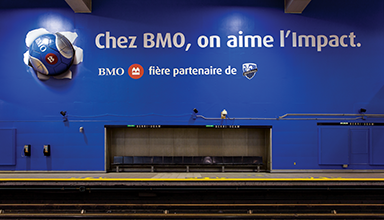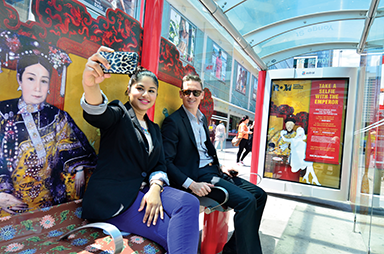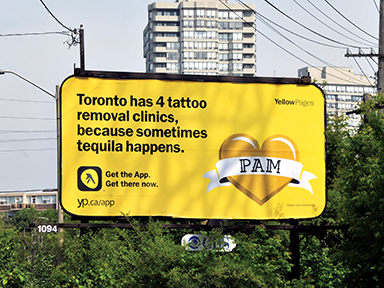OOH Advertising: New initiatives for stronger engagement
by all | 4 December 2014 9:47 am
 [1]
[1]By Rosanne Caron
Out-of-home (OOH) advertising revenue increased by 5.5 per cent during the first half of 2014, compared to the first six months of 2013, according to data from Nielsen, with the largest spending increases in Canada coming from the telecommunications, financial services, media and alcohol advertiser categories. Further, OOH outpaced other media, as the total ad spend during the same period was up only 2.5 per cent. The share of total media dollars being allocated to OOH signage increased from 6.8 per cent in 2013 to seven per cent in 2014.
Digital OOH (DOOH) advertising is a key growth area. Members of the Out-of-Home Marketing Association of Canada (OMAC), for example, have experienced double digit growth across outdoor, indoor and transit-based DOOH networks.
As businesses continue to invest in the OOH industry, 2015 will be an exciting year with more new initiatives to inspire advertisers and agencies.
More relevant and valuable
While other types of paid media are faced with increasing fragmentation and growing levels of ‘ad avoidance,’ the attention being paid to OOH advertising remains high. A 2014 survey of more than 100,000 Canadian shoppers found slightly more than eight out of 10 shoppers (83 per cent) noticed OOH ads. Further, nearly three-quarters (71 per cent)
of them noticed more than one type of OOH format. These findings reinforce OOH’s ability to create brand connections with consumers throughout the day.
Moreover, a consumer’s state of mind when viewing or hearing an advertising message has an effect on his/her attention level and receptivity to the message. A recent study in the U.K. recorded people’s skin conductance, to measure their emotional or cognitive arousal, and eye gaze data, to show what they were actually looking at in different environments, activities and contexts. In this way, the study was able to link people’s levels of attention arousal with cognitive and emotional processes and a recording of their visual experience.
The results of this research showed people are 33 per cent more alert when they are outside of their homes. The implications for the OOH environment are faster engagement, higher attention levels and higher receptiveness to advertising.
Thus, OOH advertising will continue to be an effective medium for generating awareness quickly. Impactful, focused communications can help build an emotional connection with a brand and motivate consumers to take action.
The advent of digital technologies and the integration of mobile and social media have created new opportunities for consumer interaction and immersive brand experiences. Evidence in this respect, showing the changing role of OOH ads, was seen in the entries for the 2014 Cannes Creative Effectiveness Awards, where analysis by the World Advertising Research Center (WARC) showed 92 per cent of the shortlisted campaigns used OOH media. WARC also observed such trends as the integration of OOH ads and social media, the use of OOH campaigns with smaller budgets and the addition of OOH ads to achieve mass coverage in markets where TV audiences have become fragmented. (Only 58 per cent of the shortlisted campaigns used TV commercials, compared to 83% in 2013.)
 [2]
[2]Connected consumers
Canada has one of the world’s highest adoption rates of smartphones at
75 per cent. Smartphones have allowed people to live more of their lives on the move, particularly in terms of researching products and then planning and making purchases. Research shows smartphone owners who recall OOH ads are more likely to use their devices to locate stores, prepare shopping lists, research specific products and compare prices. And with Canadians reportedly spending an average of more than 70 per cent of their daily time outside the home, OOH ads can engage them more frequently than TV commercials or many other forms of paid media.
The Royal Ontario Museum’s (ROM’s) Forbidden City exhibit OOH campaign, by way of example, successfully positioned its brand as innovative by reaching potential customers in new ways. A completely redesigned Toronto Transit Commission (TTC) shelter invited passengers and passersby to take selfies with their smartphones and submit them to the ROM to receive a discount on their admission to the exhibition.
In another example of tying in with smartphone culture, Yellow Pages promoted its mobile app with geolocation ads on various billboards, transit shelters and digital screens, as well as in fitness clubs, restaurants and bar patios. The ads highlighted—and directed consumers to—specific products, services and cultural attractions available in each neighbourhood, based in part on what people in that neighbourhood had been looking for online.
A Scotiabank campaign for an American Express card, meanwhile, focused on transit passengers to emphasize the card’s travel rewards program. This effort included transit station billboards and posters, streetcar interior dominations and both bus and light-rail transit (LRT) vehicle wraps. Notably, the interior dominations incorporated vinyl strips on the streetcars’ windows with both Near Field Communication (NFC) and Quick Response (QR) code technologies. When passengers tapped the vinyl strip with a compatible smartphone or other mobile device, they were taken to an online contest page where they could win a prize.
This type of campaign is expected to become more popular in the future as wireless-fidelity (Wi-Fi) services are rolled out across transit systems, allowing more passengers to connect to the Internet while on the go and, thus, providing a greater opportunity for advertisers to engage a captive audience.
Further, Apple’s adoption of NFC technology in its latest iPhones will help make such applications mainstream. And whereas with NFC, the consumer needs to make a choice to engage with an ad, Apple’s iBeacons can ‘push’ a message to every connected device within a wireless range of 50 m (164 ft).
The OOH environment acts as a stimulus to promote mobile device use, sparking online searches and social media conversations that can lead to greater brand interest and purchases. Studies show 42 per cent of Canadian mobile-device users express interest in interacting with OOH ads, with the highest interest seen among 18- to 34-year-olds, followed by 35- to 54-year-olds. Meanwhile, almost one-third of mobile subscribers— 32 per cent—say they would be interested in redeeming an online coupon at a retail location; and 29 per cent say they would be interested in scanning a bar code or QR code on an OOH ad.
Digital opportunities in context
With more than 10,000 DOOH screens in various venues, outdoors at street level and mounted throughout rapid transit systems, the public’s awareness of digital signage continues to grow. On a weekly basis, recall of DOOH ads among Canadian shoppers who own a smartphone is highest in Toronto at 41 per cent, followed by Montreal at 36 per cent and Vancouver at 32 per cent.
The DOOH medium is expected to grow as advertisers exploit the creative flexibility of the technology to deliver real-time content, geotargeting and interactive experiences. One of the reasons marketers are attracted to DOOH media is the technology’s emerging capabilities for measuring the effectiveness of different content and offers, in the interest of providing valuable campaign metrics back to the advertisers.

Indoor DOOH networks, especially, at places like restaurants, airports, gyms, shopping malls and bars can take advantage of unique contextual opportunities to connect with the public, based on a specific environment and lifestyle. Quebec’s Commission de la Santé et de la Sécurité du Travail (CSST), for example, used a combination of interactive digital signage terminals and static posters at colleges and universities across the province to create greater awareness among young people—the elusive under-24 age group—of the dangers of work-related accidents (see Sign Media Canada, September 2014, page 16).
Each terminal’s screen displayed the image of a young injured person lying in a hospital bed, but when a student approached the terminal, the system took a photo of him/her to replace the one on the screen. In this way, the campaign used digital signage technology to bring to life the real possibility of a young university or college student becoming the victim of an accident at work.
Maximizing impact
The OOH industry offers unlimited creative possibilities through a wide variety of formats, locations and technologies, allowing advertiers to create impactful, memorable messages. With so many possibilities, however, it can become challenging to determine which types of communications are the most effective.
With that issue in mind, OMAC recently identified a need for a creative ‘pre-testing’ tool to help marketers and their ad agencies maximize the potential impact of their OOH campaigns. The association partnered with Toronto-based BrandSpark International, a marketing and product research company, to develop and introduce AdSpark, which uses an online shopper panel and recruits consumers as identified and targeted by the client.
With AdSpark, OOH advertisers can help confirm a campaign’s overall effectiveness before it is rolled out and determine which specific elements resonate the most with consumers. The tool uses a real-world simulation period of between one and 10 seconds, depending on the specific OOH format, to measure the ‘attention value’ of specific ad content. The client receives a creative report card, including grades for likeability, relevance and favour for the brand.
Supporting Canadian communities
It is also important for OOH firms to show support for the communities in which they operate. OMAC members, for example, promote artists and their work through a variety of programs. They also support charities, not-for-profit organizations and community events by providing more than $15 million worth of free advertising space to hundreds of groups across Canada
each year. These efforts help increase awareness of the groups’ services, as well as fundraise for donations and recruit volunteers.
Another sign of community support is the use of DOOH billboards in major Canadian cities to display Amber alerts. These alerts, which publicize child abductions, can reach thousands of people within minutes. OMAC members are strongly committed to their involvement in this program and are planning to expand it to more markets.
Rosanne Caron is president of the Out-of-Home Marketing Association of Canada (OMAC) and a member of Sign Media Canada’s editorial advisory board (EAB). OMAC’s members include Astral Out-of-Home, CBS Outdoor (now Outfront Media), Cogeco Métromédia, Lamar Transit Advertising, Pattison Outdoor and Zoom Media. For more information, contact her via e-mail at rcaron@omaccanada.ca or visit www.omaccanada.ca.
- [Image]: http://www.signmedia.ca/wp-content/uploads/2014/12/CogecoBMO.png
- [Image]: http://www.signmedia.ca/wp-content/uploads/2014/12/AstralRW29947.png
Source URL: https://www.signmedia.ca/ooh-advertising-new-initiatives-for-stronger-engagement/